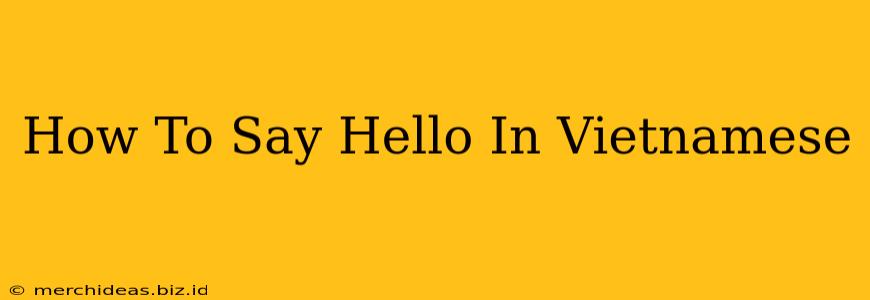Learning a new language can be exciting, and Vietnamese is no exception! Knowing how to greet someone is the first step in any language learning journey. This guide will teach you various ways to say "hello" in Vietnamese, from formal to informal, and help you navigate different social situations.
The Basics: "Xin chào"
The most common and versatile way to say "hello" in Vietnamese is **"Xin chào" (pronounced sin chow) **. This phrase works in almost any situation and is suitable for both formal and informal settings. It's a safe bet and a great starting point for your Vietnamese language adventure.
Using Xin Chào Effectively
- Tonality Matters: While the pronunciation is relatively straightforward, pay attention to the tone. Vietnamese is a tonal language, meaning the meaning of a word can change depending on the tone. Practicing the correct intonation is crucial for clear communication.
- Context is Key: While "Xin chào" is generally accepted, understanding the context helps you choose more appropriate greetings later on.
- Responding: The typical response to "Xin chào" is simply "Xin chào" back, or a more elaborate greeting depending on the time of day (more on that below!).
Beyond the Basics: More Ways to Greet in Vietnamese
While "Xin chào" is your go-to phrase, there are other ways to greet someone in Vietnamese, depending on the time of day or level of formality.
Morning Greetings
- "Chào buổi sáng" (Chow bwoy sang): This translates to "Good morning" and is used from sunrise to about midday.
Afternoon Greetings
- "Chào buổi chiều" (Chow bwoy chieu): Meaning "Good afternoon," this greeting is appropriate from midday until evening.
Evening Greetings
- "Chào buổi tối" (Chow bwoy toi): This translates to "Good evening" or "Good night" and is used from evening onwards.
Informal Greetings Among Friends
For close friends and family, you can use more informal greetings:
- "Hi" (hee): The English word "hi" is widely understood and accepted in informal settings.
- "Alo" (a-lo): This is a more casual greeting, often used when answering the phone or greeting someone unexpectedly.
Politeness Counts: Formal Greetings in Vietnamese
Vietnamese culture places a high value on respect and politeness. For more formal settings, such as business meetings or interactions with elders, you can show your respect with:
- Adding "ạ" (a): Adding "ạ" (a) to the end of your greeting makes it more polite and respectful. For example, "Xin chào ạ" (sin chow a) is a polite way to say hello. This is especially important when speaking to older people or those in positions of authority.
Mastering Vietnamese Greetings: Tips for Success
- Listen and Repeat: The best way to learn pronunciation is to listen to native speakers and practice repeating the phrases. There are many online resources and apps that can help with this.
- Immerse Yourself: If you have the opportunity, immerse yourself in the Vietnamese language and culture. This will help you understand the nuances of the language and improve your fluency.
- Practice Makes Perfect: Don't be afraid to make mistakes. The more you practice, the more confident you will become in your ability to speak Vietnamese.
Learning how to say "hello" in Vietnamese is just the beginning. With practice and a little effort, you'll be able to navigate various social situations and connect with people in a meaningful way. So, go ahead, try saying "Xin chào!"
